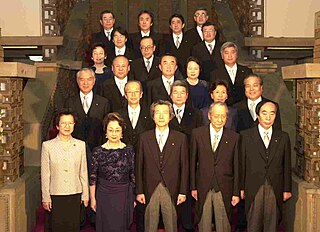
Komeito, formerly New Komeito and abbreviated NKP, is a political party in Japan founded by members of the Buddhist movement Soka Gakkai in 1964. It is generally considered as centrist and conservative. Since 2012, it has served in government as the junior coalition partner of the nationalist and conservative governments lead by the Liberal Democratic Party.

The Liberal Democratic Party, frequently abbreviated to LDP or Jimintō (自民党), is a major conservative and Japanese nationalist political party in Japan.

General elections were held in Japan on November 9, 2003. Incumbent Prime Minister Junichiro Koizumi of the Liberal Democratic Party won the election but failed to secure a majority. The main opposition Democratic Party made considerable gains, winning 177 of the 480 seats in the House of Representatives, its largest share ever. Other traditional parties like the Communist Party and the Social Democratic Party lost a significant numbers of seats, marking the start of a new two-party system in Japanese politics, which would end in 2012 with the emergence of Japan Restoration Party.

The Democratic Party of Japan was a centrist to centre-left liberal or social-liberal political party in Japan from 1998 to 2016.

The New Party Sakigake, also known as the New Harbinger Party, was a political party in Japan that broke away from the Liberal Democratic Party (LDP) on 22 June 1993. The party was created by Masayoshi Takemura. The party was centrist, and had many reformist and even moderate ecological elements. The theoretical leader was Shusei Tanaka. Yukio Hatoyama and Naoto Kan also took part but later moved to the Democratic Party of Japan.

The New Frontier Party (NFP) was a big tent political party in Japan founded in December 1994. As a merger of several small parties, the party was ideologically diverse, with its membership ranging from moderate social democrats to liberals and conservatives. The party dissolved in December 1997, with Ichirō Ozawa's faction forming the Liberal Party and other splinters later joining the Democratic Party of Japan in April 1998.
Moderate is an ideological category which designates a rejection of radical or extreme views, especially in regard to politics and religion. A moderate is considered someone occupying any mainstream position avoiding extreme views. In American politics, a moderate is considered someone occupying a centre position on the left–right political spectrum.

The Liberal Party was a political party in Japan formed in 1998 by Ichirō Ozawa and Hirohisa Fujii. It is now defunct, having joined the Democratic Party of Japan in 2003.
Japanese liberalism(自由主義 or リベラリズム) formed in the nineteenth century as a reaction against traditional society. In the twentieth century 'liberal' (自由) gradually became a synonym for conservative, and today the main conservative party in the country is named Liberal Democratic Party. The defunct Democratic Party was considered in part a centrist-liberal party, as are most parties which derived from it. The liberal character of the Liberal League is disputed, as it is also considered to be conservative by some. This article is limited to liberal (リベラル) parties with substantial support, proved by having had representation in parliament.

The New Party Daichi is a Japanese political party. The party works based on jurisdiction and administrative divisions. The party's leader is Muneo Suzuki, a member of the House of Councillors who formerly caucused with the Nippon Ishin no Kai and was a Representative for the Liberal Democratic Party (LDP).

Eriko Yamatani is a Japanese politician. Her name in official documents is Eriko Ogawa.
Zenjiro Kaneko is a Japanese politician of the Liberal Democratic Party, a member of the House of Representatives in the Diet. A native of Yamagata Prefecture and graduate of Hitotsubashi University, he worked at the Ministry of Home Affairs. He was elected for the first time in 2000 as a member of the Democratic Party of Japan (DPJ) but lost his seat three years later after defecting from the DPJ to join the second incarnation of the New Conservative Party. He was re-elected in 2005 as a representative for the LDP.

Factions are an accepted part of the Liberal Democratic Party (LDP), the ruling party of Japan, which began with eight formal factions when it was first formed by merger in 1955. A political faction may be defined as a sub-group within a larger organization. While factions characterize other political parties in Pacific Asia, Japanese factionalism is distinguished by its stability and institutionalization. Although factions reconstitute themselves from time to time, the habatsu active today can be traced back to their 1955 roots, a testament to the stability and institutionalized nature of Liberal Democratic Party factions.

General elections were held in Japan on 16 December 2012. Voters gave the Liberal Democratic Party a landslide victory, ejecting the Democratic Party from power after three years. It was the fourth worst defeat suffered by a ruling party in Japanese history.

The New Renaissance Party was a minor political party in Japan.
The Democratic Party, abbreviated as DP, was a political party in Japan. It was the largest opposition political party in Japan from 2016 until its marginalization in the House of Representatives in 2017. The party was founded on 27 March 2016 from the merger of the Democratic Party of Japan and the Japan Innovation Party. The majority of the party split on 28 September 2017, before the 2017 general election, with many its members contesting the election as candidates for the Party of Hope, Constitutional Democratic Party of Japan or as party members without nomination. On 7 May 2018 the DP merged with the Party of Hope to form the Democratic Party for the People.

The First Koizumi Cabinet governed Japan from April 2001 until November 2003 under the leadership of Prime Minister Junichiro Koizumi, who came to power after winning a surprise victory in the LDP presidential election of 2001. The cabinet continued the LDP-Komeito-NCP coalition and contained a record number of 5 women, including Makiko Tanaka as the first female Foreign Minister. Several ministers from the previous Mori Administration remained in office to ensure the continuity and stability of government. Unusually for an LDP leader, Koizumi chose his cabinet himself and personally asked ministers to join the government, unlike previous practice where party factional leaders often chose government posts.
The Conservative Party of Japan is a conservative, Japanese nationalist and right-wing populist political party in Japan founded by novelist Naoki Hyakuta and journalist Kaori Arimoto in 2023 following the passage of the LGBT Understanding Promotion Act. The party, claiming to "protect Japan's national polity and traditional culture" is often characterised as being opposed to immigration, xenophobic, and uses historically revisionist rhetoric, with party leaders often engaging in discriminatory remarks towards foreigners and sexual minorities, as well as denying Japanese war crimes committed prior to and during the Second World War, such as the Nanjing Massacre.
Anti-American conservative is a political term used in Japan that refers to a case in which conservatives in the country display anti-American views diplomatically or culturally.













